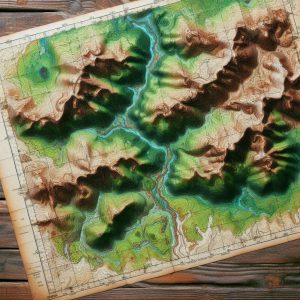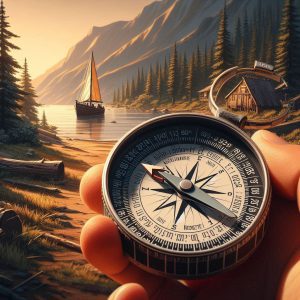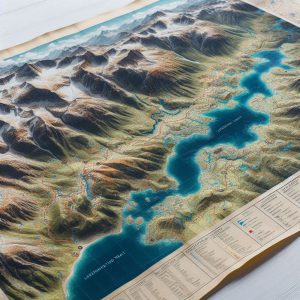Sharpen Your Wilderness Navigation Skills: A Practical Guide for Adventurers Embracing Nature Without GPS
Acquiring the essential skills of map and compass navigation is a transformative journey that enriches your outdoor experiences and empowers you to explore the wilderness with confidence. While the idea of navigating without modern technology may seem daunting, it is a rewarding endeavor that fosters a deeper connection with nature. Understanding your surroundings and accurately determining your position relative to your destination is crucial. A map provides a comprehensive two-dimensional representation of the landscape, while a compass serves as a reliable tool for orienting yourself according to the cardinal directions of north, south, east, and west. By mastering these traditional navigation tools, you can venture into the great outdoors without the crutch of digital devices.
To embark on your navigation journey, start by immersing yourself in the various symbols, scales, and features depicted on a map. Understanding these elements is vital for accurate interpretation of the landscape. Learning to read contour lines, which signify elevation changes, is essential. This skill enables you to identify geographical features such as hills, valleys, and other obstacles that could affect your chosen route. In addition, becoming proficient in compass usage is equally important, as it allows you to navigate the wilderness effectively, independent of GPS reliance.
The compass needle consistently points toward magnetic north, making it an invaluable tool for aligning your map with the actual terrain. To achieve this, hold the compass level in your hand and rotate the map until the magnetic north indicated on the compass aligns with the north displayed on the map. This essential technique, known as “orienting the map,” is crucial for maintaining accuracy in your navigation efforts, ensuring that you remain on the right path throughout your journey.
Once the map is properly oriented, you can utilize the compass to take accurate bearings that will guide your travel direction. By effectively combining these two navigational instruments—the map and the compass—you will confidently navigate through unfamiliar landscapes, ensuring that you remain on track, even in the absence of modern technological aids.
Key Principles for Successful and Confident Outdoor Navigation
- Acquiring expertise in map and compass navigation is essential for anyone involved in wilderness exploration or outdoor endeavors.
- Topographic maps provide intricate details about terrain, elevation, and natural features, which are critical for effective navigation.
- A compass not only determines direction but also aids navigation by aligning with the map’s orientation and understanding magnetic north.
- Natural landmarks and indicators, such as distinctive rock formations or unique tree arrangements, can serve as valuable navigational aids when a map or compass is unavailable.
- Estimating distance and travel time is crucial for planning and executing a successful navigation strategy in the wilderness.
 The Critical Importance of Topographic Maps in Navigating Wilderness Areas
The Critical Importance of Topographic Maps in Navigating Wilderness Areas
Topographic maps are essential resources for anyone planning an expedition into natural landscapes. They contain detailed information about the physical characteristics of the terrain, utilizing contour lines to represent changes in elevation. This representation enables you to visualize the shape and steepness of the landscape, adequately preparing you for the challenges ahead. Each contour line connects points of equal elevation, and the spacing between these lines reveals whether the slope is steep or gradual—this knowledge is crucial for effective navigation.
Understanding Contour Lines and Map Symbols for Enhanced Navigation
When you examine a topographic map, it is essential to analyze the patterns formed by contour lines; closely spaced lines indicate steep terrain, while widely spaced lines signify flatter areas. This insight empowers you to anticipate potential obstacles along your route, allowing for informed navigation decisions. Additionally, topographic maps are rich with symbols representing various landmarks, including rivers, roads, trails, and different types of vegetation. Familiarizing yourself with these symbols is foundational for effective navigation, ensuring you can utilize the map to its fullest potential and navigate confidently.
Mastering Navigation Techniques with Topographic Maps
For example, blue lines typically represent water bodies, such as streams or lakes, while green areas may indicate forests or other dense vegetation. By correlating these symbols with your surroundings, you can validate your location and make necessary adjustments to your route. Moreover, topographic maps often feature grid lines that assist in pinpointing coordinates, enhancing precision in navigation. By mastering the intricacies of topographic maps, you will deepen your appreciation for the landscape while significantly improving your overall navigational skills in the wild.
 Harnessing the Power of a Compass for Accurate Directional Navigation
Harnessing the Power of a Compass for Accurate Directional Navigation
A compass is an indispensable tool for any adventurer, providing invaluable assistance in directional navigation, particularly in unfamiliar landscapes. To use a compass effectively, hold it level in front of you and allow the needle to stabilize. The needle will point toward magnetic north, which may slightly differ from true north due to magnetic declination—the angle between magnetic north and true north varies based on your geographical location.
Before embarking on your journey, it is imperative to determine the local declination and adjust your compass accordingly. This adjustment is crucial for maintaining accurate bearings, ensuring you stay on course throughout your adventure. Once your compass is calibrated for declination, you can proceed to take a bearing that will guide your direction of travel.
To take a bearing, identify a landmark you wish to navigate toward and rotate the compass housing until the orienting arrow aligns with the magnetic needle. The degree reading on the compass dial that aligns with the index line indicates your bearing. As you move toward your destination, periodically check your bearing to confirm you remain on the correct path.
If you notice yourself deviating from your intended course, reorient your compass and adjust your path as necessary. By mastering these techniques, you will gain confidence in using a compass as a reliable navigational tool during any outdoor adventure.
 Leveraging Natural Landmarks and Signs for Effective Wilderness Navigation
Leveraging Natural Landmarks and Signs for Effective Wilderness Navigation
While maps and compasses are fundamental navigational tools, keenly observing natural landmarks and cues can significantly enhance your ability to navigate the wilderness effectively. Distinctive features such as mountains, rivers, and unique trees can serve as invaluable reference points while traversing unfamiliar terrain. For instance, if you know a specific mountain lies to the east of your starting position, you can use it as a reliable guide to confirm you’re heading in the correct direction.
Furthermore, familiarizing yourself with the unique characteristics of your surroundings will aid in forming mental maps, enabling you to navigate without solely depending on tools. In addition to prominent landmarks, pay attention to natural signs that may indicate direction or changes in terrain. The sun’s position is a helpful guide; in the northern hemisphere, the sun rises in the east and sets in the west, providing a general sense of direction throughout the day.
Moreover, observing moss growth on trees—often more abundant on the north side—can offer valuable clues about orientation in dense forests. Animal trails can also provide directional hints; many animals follow established paths leading to water sources or other significant landmarks. By refining your ability to interpret these natural signs, you will enhance your skills in navigating diverse environments, making you a more adept wilderness explorer.
Strategically Estimating Distance and Travel Time for Successful Wilderness Navigation
Accurately estimating distance and travel time is essential for successful navigation in wilderness areas. Understanding how far you've traveled and the expected time to reach your destination is crucial for effective planning and helps you avoid unforeseen challenges. One practical technique for estimating distance is pacing—counting your steps as you walk.
On average, an adult’s stride is approximately 2.5 feet, so by counting your steps over a known distance, you can gauge how far you've traveled based on your pace. Additionally, consider the type of terrain and elevation changes when estimating travel time. For instance, traversing flat ground typically allows for quicker movement compared to navigating steep hills or rocky paths.
A common guideline suggests that you can cover roughly three miles per hour on flat terrain, but this estimate should be adjusted significantly when encountering challenging landscapes. By factoring in these variables and modifying your expectations accordingly, you will be better prepared for your journey and more capable of managing your time effectively, ensuring a more successful navigation experience.
Developing a Comprehensive Wilderness Route and Navigation Strategy
Crafting Your Wilderness Route for Optimal Navigation
Formulating an effective navigation plan is crucial before embarking on any wilderness adventure. Begin by analyzing topographic maps of the area you intend to explore, pinpointing potential routes based on prominent landmarks, existing trails, and available water sources. As you construct your route, consider factors such as elevation changes and terrain difficulty; ensuring your plan is realistic and achievable is of utmost importance for a successful journey.
Preparing for Unexpected Obstacles and Weather Changes During Your Adventure
While planning your route, it’s prudent to consider alternative paths in case you encounter unforeseen obstacles or sudden shifts in weather conditions. Having multiple options will provide you with greater flexibility during your journey and contribute to your overall safety. This adaptability is essential for a successful and enjoyable wilderness experience, empowering you to navigate any challenges that may arise seamlessly.
Creating a Detailed Navigation Strategy with Key Waypoints
Once you've mapped out potential routes, develop a detailed navigation plan that includes key waypoints. Mark these waypoints on your map and, if possible, note their coordinates, allowing you to track your progress as you navigate through the wilderness. Additionally, incorporate estimated travel times between waypoints and identify any potential hazards that may arise along your chosen route. This comprehensive strategy will enhance your confidence as you navigate.
Ensuring a Safe and Rewarding Outdoor Experience Through Thorough Planning
Effective planning and anticipating challenges significantly enhance your chances of reaching your destination while enjoying a safe and fulfilling outdoor experience. A well-organized navigation strategy is vital for a successful wilderness adventure, ensuring that you can explore the great outdoors with confidence and assurance, prepared for whatever nature may present.
 Implementing Emergency Navigation Techniques for Unforeseen Scenarios
Implementing Emergency Navigation Techniques for Unforeseen Scenarios
Despite careful planning and preparation, unexpected circumstances may arise during outdoor adventures that necessitate the use of emergency navigation techniques. One crucial skill is the ability to backtrack; if you find yourself lost or disoriented, retracing your steps can often lead you back to familiar territory. To execute this effectively, pay close attention to distinctive landmarks or features along your route, which can serve as reference points when returning.
Another invaluable technique is celestial navigation, particularly useful when visibility permits—especially on clear nights or sunny days when stars or celestial bodies are visible. Familiarizing yourself with prominent constellations, such as the North Star (Polaris) in the northern hemisphere, can provide guidance, as it remains relatively fixed in position while other stars shift. By locating Polaris and determining its angle above the horizon, you can ascertain true north without relying on a compass or map, enhancing your navigational capabilities.
If you have a wristwatch or smartphone as a backup, utilizing it alongside celestial navigation can bolster your sense of direction during emergencies, helping you maintain your orientation even in challenging situations where traditional tools may fail.
Enhance Your Wilderness Navigation Skills: Practical Strategies for Continuous Improvement
Improving your wilderness navigation skills requires commitment and practice, but the rewards can significantly enrich your outdoor experiences. One effective strategy is to join local hiking groups or outdoor clubs, where members can share their knowledge and experiences related to navigation techniques. Engaging with seasoned navigators can provide valuable insights into best practices while offering hands-on learning opportunities across various terrains.
Another advantageous approach involves regularly practicing with maps and compasses in diverse environments—whether in urban settings or remote wilderness areas—to build your confidence in these essential skills. Set aside time for solo excursions where you intentionally navigate without technological aids; this method will reinforce your abilities while allowing you to connect more deeply with nature. Furthermore, consider maintaining a navigation journal to document routes taken, challenges faced, and lessons learned during each adventure; this reflective practice will not only enhance your skills but also deepen your appreciation for navigating diverse landscapes.
By embracing these techniques and continuously refining your skills in map reading, compass usage, natural observation, distance estimation, route planning, emergency strategies, and sharing practical experiences with others, you will evolve into a more self-assured navigator, capable of thriving in any wilderness environment, even without the support of technology.
Common Questions About Wilderness Navigation and Techniques
What does wilderness navigation involve?
Wilderness navigation encompasses the skills and techniques required to determine and maintain a route through natural, often remote, and undeveloped areas. It involves utilizing various tools and methods to stay on course and safely reach a desired destination.
What traditional methods are used in wilderness navigation?
Traditional wilderness navigation methods include employing a map and compass, interpreting topographic features, observing natural landmarks, and applying celestial navigation techniques based on the sun, moon, and stars.
Why might someone prefer to navigate without GPS?
Many individuals choose to navigate without GPS for various reasons, including the desire to enhance their wilderness navigation skills, embrace the challenge of traditional methods, or prepare for potential GPS malfunctions or limited access to technology.
What advantages come with learning wilderness navigation without relying on GPS?
Learning wilderness navigation techniques independent of GPS can deepen one’s understanding of the natural environment, increase self-reliance and confidence, and provide a dependable backup plan in case of technology failures or restricted access to GPS devices.
What challenges may occur when navigating in the wilderness without GPS?
Challenges related to wilderness navigation without GPS include the necessity for advanced planning, the potential for human error, and reliance on environmental factors such as weather and visibility conditions, all of which can influence navigation accuracy.
The post Wilderness Navigation Techniques Without GPS appeared first on Survival Bite.
The Article Wilderness Navigation Techniques for Off-Grid Adventures Was Found On https://limitsofstrategy.com
The Article Wilderness Navigation Techniques for Off-Grid Explorers First Appeared ON
: https://ad4sc.com

 Harnessing the Power of a Compass for Accurate Directional Navigation
Harnessing the Power of a Compass for Accurate Directional Navigation Leveraging Natural Landmarks and Signs for Effective Wilderness Navigation
Leveraging Natural Landmarks and Signs for Effective Wilderness Navigation
 Implementing Emergency Navigation Techniques for Unforeseen Scenarios
Implementing Emergency Navigation Techniques for Unforeseen Scenarios




No responses yet